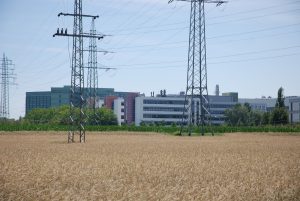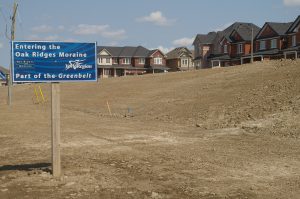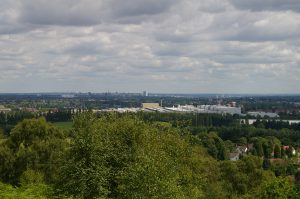By Roger Keil
Thinking about suburbanization and suburbanisms can be an exercise in addressing ‘boundaries’. The transition from city to countryside has always been a critical interface of human existence. Since antiquity, the inside/outside problematic has been a central concern of urbanism: walls, moats, gates. Boundaries have forever defined the urban. I can think of no better word than the German Stadtkante (city edge) to denote the stark spatiality of separation that has historically defined our urban reality. Historically, the clear break between the city and the hinterland has come in one of two ways: the edge (as in the common use of Stadtkante) and the sprawl. Clearly, the former has historical significance as a defensive built environment. A sprawling mesh of settlement can hardly keep the enemy at bay in a warfare based on brute physical conquest! Whether this is any different in today’s world of urban bellicism would need to be demonstrated (Graham 2011). But the boundary between the urban and the suburban has also always been set by social process and socioecological metabolism.
Jon Teaford reminds us: “Suburbs have existed virtually as long as cities. Since ancient times functions and activities that could not exist within the walls or limits of the dense core of the city have gravitated to the periphery. Sprawling livestock yards and brickfields as well as noxious slaughterhouses have been forced to operate on the edge of cities. In the pre-modern era they were joined by the immoral or illegal pursuits of prostitutes or unlicensed hucksters expelled from the walled core. For centuries the very wealthy sought escape from the city to outlying villas where they enjoyed summers in a semi-rural setting. The fringe represented freedom from the city – the ability to do what was not allowed or impossible within the densely-populated core” (Teaford 2011: 15).
Boundaries, then, are historico-spatial products of relationships between urban activities and non-urban activities. Needless to say this kind of dichotomous thinking needs to be interrogated in a postsuburban world (Phelps & Wu 2011). But this is for another time. In this post, I want to focus on the meaning of greenbelts as boundaries.
I take my first cue from Walter Prigge’s enlightening treatment of Benjamin’s “Schwellenkunde” following Winfried Menninghaus’s (1986) book of the same name. Prigge’s treatment of the Frankfurt GreenBelt as a “transition” or “threshold” leads to a remarkable set of observations. It also qualifies any talk of boundary as clear as a firm line immediately. Following Prigge (and Benjamin) such a “threshold” is to be differentiated sharply from the conventional idea of boundary. The threshold has a spatial quality, it is not just a line. Related concepts are zone, change, transition, floods. The idea of a liminal space is not far from this concept. They seem to be spaces where “the ambiguous” (Zweideutiges) replaces the actual (das Eigentliche) (1991: 173). Prigge notes that “on the threshold two different spaces overlap: it is open to both, free from the unilateral constraints of the one or the other, however touched by the determinations and uses of both” (1991: 173). Crossing the threshold changes the perspective (there are reverberations here of Benjamin’s famous dreamspaces).
The greenbelt as threshold points to the central contradictions of modern metropolitanity of which suburbanization is a major factor. Prigge explains:
“Metropolitanization signifies the profound change of social structures: with the transformation of social spaces and times into fragmented places and histories, ‘city’, ‘land’, ‘centre’ and ‘periphery’ into obsolete concepts. We need to define their objects and relations in a new way. The Frankfurt GreenBelt, itself a space that is fragmented by fractures between ‘city’ and ‘nature’, is place and opportunity of such a redefinition” (Prigge 1991: 175). Perhaps this is a good threshold from which to understand the relationship of greenbelts and suburbs more generally? (One thing that needs immediate attention is the fact that suburbanization is now so pervasive that it is present on both sides of the greenbelt – poses questions of inside/outside relations). In fact, this reminds one of Reyner Banham’s (1970) famous observation that when Angelenos enter the city by exiting the freeway and switching to surface roads, they cross the boundary between the outside and the inside. Rather than being a hard line, this is now a space for multi - faceted negotiation. Similarly, the greenbelt becomes an instance of the kind of “rural urbanism” which Laura Barraclough has examined in the San Fernando Valley in Los Angeles: “The San Fernando Valley actually has a far more complex past in which rurality, suburbia, and urbanity have coexisted, often tensely… the Valley’s distinctive mélange of rural, suburban, and urban landscapes attests to competing visions of the kind of place the San Fernando Valley has been and will become – visions that are intimately linked to the ways in which racial, class, and national identities are being negotiated in Los Angeles and the Metropolitan U.S. West” (Barraclough 2011: 3).
The developmental dynamics of the boundary setting that greenbelts perform in an era of global suburbanization are vastly different in various places. In the old industrial landscapes of Birmingham and the Emscher, grass grows literally over the ruins of an obsolete spatial fix. In the booming regions of Toronto, Frankfurt (and Seoul?), greenbelts are expansion spaces and projection screens where the global city is going up the country (Keil and Ronneberger 1994). In the case of the Canadian oil town of Fort McMurray in Alberta, Rob Shields (2012) discovers a particular “feral suburbanism” without much of a boundary between the vinyl suburban world of universal subdivisions and the bogs and swamps of an unforgiving nature just beyond. Here we encounter a similar, yet starkly contrasting set of societal relationships with nature as we see in the desert suburbs of Southern California.
Another central terrain for negotiation of city and non-city is the political and social ecology of the greenbelt. While we can imagine the metabolism of the urban region as a seamless web of human and non-human life with metabolic streams connecting organisms, we also must recognize the obstacles and facilitating channels by which those streams are conditioned. In terms of urban political ecology, we have recently become accustomed to the idea that “sustainable urban development” is better achieved in compact dense cities than in sprawling low-density suburban forms of settlement (Keil & Whitehead 2012). Yet we may have to rethink, again, such simple opposition of densities as a single marker of sustainable metabolic relationships. The greenbelt, as a negotiated space of societal relationships of nature that connect urban and non-urban activities becomes an additional canvas for the production of (social/urban) nature where suburbanization and urbanization are enclosed, enabled and energized.
Giving up the singular focus on density and car-dependency as markers of suburban development, allows us to move into a more complex conceptual landscape to describe what is actually on both sides of the greenbelts that hedge in urban agglomerations. We arrive at admitting that the entire urbanized region has begun to develop in a rather patchwork-type way. As Tom Sieverts (2003; 2011; forthcoming) has reminded us, even the green spaces beyond the traditional city cores are now perforated in dramatic ways and have become part of the “inbetween” cites that are typical for this age. John Friedmann has reintroduced Nietzsche’s concept of “Fernstenliebe” (the love of those who are far away) as a critique of “Nächstenliebe” (the love of your neighbour). Friedmann points out that a greenbelt contains an ethics of enclosure; the metaphor of the belt is one of control over flows. How realistic and how sustainable is that in today’s world? Can this really be a boundary that holds?
This relates ultimately to the relationship of agriculture and the city: the infrastructure of the agricultural mode of production now becomes a new spatial fix for the post(sub)urban realities of the regional metropolis. The greenbelt holds as a boundary for suburban development and becomes the dreamspace threshold for alternative uses of green space. Instead of agriculture, we are now getting para-agriculture. Horse farms, trailer parks, Christmas tree plantations, apple farms for picking and fall festivals replace the traditional agricultural activities that structured the landscape of the greenbelt over many generations.
One more glance back to the historico-geographic gestalt of the greenbelt: Sieverts (forthcoming) sees the postindustrial as a space of new possibilities: at the scale of an entire landscape, greenbelts act as a focus for meaning making. They are the historical thresholds between industrial and postindustrial landscapes (Birmingham, Emscher). Besides this temporal boundary between the modernism and industrialism of the previous period and the fragmented post-industrialism of the current period there is also now the spatial boundaries between different imaginaries in which the urban is refracted: is this golf course in the greenbelt urban, suburban or rural?
The landscape beyond the city in which the greenbelts have been established has long been a rural landscape. The infrastructures that have been laid out there have facilitated agricultural production and, in the cases of Birmingham and the Emscher, also industrial or mining activities. In this sense, the greenbelts’ matrix has been inscribed in physical and social terms as non-urban. Yet today’s greenbelts have to be seen not as qualitatively different from urban structures and relationships but rather as conjugations of postsuburban relationships. The design and use of those greenbelts today are taking shape not against but in conversation with the push of suburban expansion that surrounds those greenspaces. The use of infrastructures in the greenbelt is not anymore governed by the primacy of agricultural pursuits but by the interests of urbanites in real and imagined green landscapes. Para-agricultural uses (horse farms for horseback riding by urban kids for example) trump traditional agricultural pastimes. The musealization of industrial histories replaces the actual industrial production in greenbelts.
Where does this take us? Suburbanization redefines urban boundaries conceptually and physically. Chief among those is the constantly changing relationship of nature and urban society. Metropolitan governance works those boundaries through buffer zones (greenbelts, wedges, fingers, urban national parks) that contain and govern suburban expansion and/or conserve natural or agricultural landscapes around metropolitan centres. A global movement, the greenbelt initiatives are now imposing themselves on the political discourses of a variety of urban areas around the world. In Toronto, Birmingham, the Ruhr, Frankfurt, Seoul, and Delhi/Gurgaon such attempts at threshold politics are particularly visible. We will study those in our project.
References:
Banham, R. (1970). Los Angeles: The Architecture of Four Ecologies.
Barraclough, L R. (2011). Making the San Fernando Valley: Rural Landscapes, Urban Development, and White Privilege. Athens & London: University of Georgia Press.
Friedmann, J. (1991). Wem gehört er? Kommune. 9,6, June: 36
Graham, S. (2010). Cities Under Siege: The New Military Urbanism. London: Verso.
Keil, R. (2011). Frontiers of urban political ecology. In M. Gandy (ed.) Urban Constellations. Berlin: Jovis Verlag.
Keil, R. & Whitehead, M. (2012). Cities and the Politics of Sustainability. In Oxford Handbook of Urban Politics. Oxford: Oxford University Press.
Menninghaus, W. (1986). Schwellenkunde: Walter Benjamins Passage des Mythos. Frankfurt.
Phelps, N.A. & Wu, F. (eds.)(2011). International Perspectives on Suburbanization: A Post-Suburban World. London: Palgrave Macmillan.
Prigge, W. (1991). Übergänge: Auf der Schwelle einer neuen Stadtentwicklungspolitik. In T. Koenigs (ed.) Vision offener Grünräume: GrünGürtel Frankfurt. Frankfurt & New York: Campus Verlag, pp. 173-8.
Shields, R. (2012). Feral suburbs: Cultural topologies of social reproduction, Fort Murray, Canada, International Journal of Cultural Studies.
Sieverts, T. (2003). Cities without Cities: An Interpretation of the Zwischenstadt. London & New York: Routledge.
Sieverts, T. (2011). The In-Between City as an Image of Society: From the Impossible Order Towards a Possible Disorder in the Urban Landscape. In D. Young, P.B. Wood & R. Keil (eds.) In-Between Infrastructure: Urban Connectivity in an Age of Vulnerability. Kelowna: Praxis (e) Press.
Sieverts, T. (2015). On the relations of Culture and suburbia: How to give meaning to the suburban landscape? In P. Hamel & R. Keil (eds.) Suburban Governance: A Global View. Toronto: University of Toronto Press.
Teaford, J.C. (2011). Suburbia and Post-suburbia: A Brief History. In N.A. Phelps & F. Wu (eds.) International Perspectives on Suburbanization: A Post-Suburban World? London: Palgrave Macmillan.





Comment on “Boundaries: Shackling suburbia or outlining the post-metropolis?”